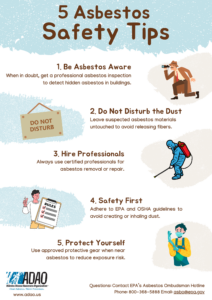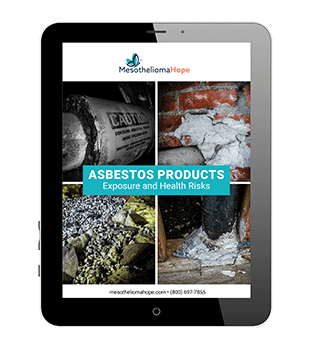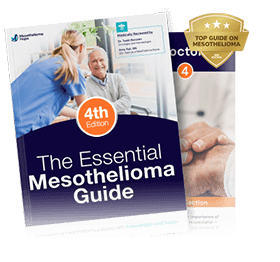On April 30, 2024, the Asbestos Disease Awareness Organization (ADAO) hosted a webinar discussing legacy asbestos exposure and the importance of legislation to reduce the long-term health risks. Over 100 participants from wide-ranging companies, government agencies, and other professional organizations attended the live event.
Exposure to asbestos can cause serious diseases like mesothelioma and lung cancer. However, symptoms can take 10-50 years to first appear.
ADAO Co-founder and President Linda Reinstein led and moderated a panel of several leading experts in the field of mesothelioma treatment, environmental health and safety, emergency service provider advocacy, and environmental litigation.
Panelists included:
- Dr. Raja Flores, Chairman of the Department of Thoracic Surgery and the Steven and Ann Ames Professor in Thoracic Surgery at Mount Sinai Health System
- Brent Kynoch, Managing Director of the Environmental Information Association (EIA)
- Greg Russell, Governmental Affairs Representative for the International Association of Fire Fighters (IAFF)
- Dr. Dan Whu, Chief Medical Officer for the IAFF
- Bob Sussman, Legal Counsel for the ADAO
A culmination of Global Asbestos Awareness Month 2024, the webinar covered various topics related to legacy asbestos, the risks of exposure, and what can be done to safely address the issue. A recording of the webinar is available to those who were unable to attend live.
What Is Legacy Asbestos?
Legacy asbestos refers to asbestos that continues to exist in older buildings, cars, homes, household appliances, and consumer products primarily made before 1980.
Over 25 million homes across the country may still contain asbestos. When these older homes are renovated, rebuilt, or damaged, asbestos can be disturbed, putting those nearby at risk of breathing in or swallowing airborne asbestos fibers.
Legacy asbestos can be found in products like:
- Electrical wire insulation
- Fireproofing materials
- Popcorn ceilings
- Pipe insulation
- Drywall joint compound
- Tiles
The largest known legacy exposure incident occurred when the World Trade Center towers collapsed on 9/11, subjecting over half a million New Yorkers to 400 tons of cancer-causing asbestos.
For this reason, IAFF Chief Medical Officer Dr. Dan Whu refers to asbestos as “the gift that keeps on hurting.”
Download our Free Asbestos Guide to learn more about the products that could contain legacy asbestos and what to do if exposed.
How to Prevent Exposure to Legacy Asbestos
The ADAO webinar also outlined specific ways to prevent exposure to legacy asbestos.

Unfortunately, only some are in a position to know about the presence of asbestos ahead of time or have the ability to test for it beforehand.
Firefighters and the Risks of Legacy Asbestos
While many don’t know the grave risks of asbestos exposure, the same cannot be said for firefighters, who are often exposed unknowingly in the line of duty.
Due to the urgent nature of their work, firefighters can’t find out beforehand if a home they’re called to contains legacy asbestos.
“Fire liberates asbestos,” said IAFF Chief Medical Officer Dr. Dan Whu, with the result being that “firefighters face uniquely extreme asbestos exposure risk.”
Consequently, firefighters are twice as likely to develop mesothelioma than the general public, with cancer being the leading cause of death in this occupation.
Other occupations at risk of asbestos exposure include:
- Auto mechanics
- Boilermakers
- Construction workers
- Electricians
- Insulators
- Military veterans
- Plumbers
- Shipyard workers
- Teachers
- Family members of these workers
The microscopic asbestos fibers can travel home on the clothing and equipment of exposed workers, potentially harming their loved ones in what’s known as secondhand exposure.
The everyday person could even be exposed to asbestos dust from a construction site simply by walking down the street.
Unfortunately, these fibers can never be removed once they are in the body, which emphasizes the need to get rid of legacy asbestos to prevent future harm to the public.
Regulation vs. Legislation: Why the March 2024 EPA Ban Isn’t Enough
Despite asbestos being banned in nearly 70 countries and irrefutable medical evidence establishing the link between asbestos exposure and cancer, the United States has been slow to catch up.
So far, federal asbestos regulations have not held up to the test of time — or the pressures of the asbestos industry. In 1989, the U.S. Environmental Protection Agency (EPA) passed an asbestos ban, but it was overturned in 1991.
For the next 25 years, progress toward banning all forms of asbestos stalled — until 2016, when Congress amended the Toxic Substances Control Act of 1976 and removed legal roadblocks to a potential ban.
The EPA was given stronger regulatory tools, which prompted the agency to reevaluate the risks of asbestos exposure as a first step.
“The EPA has preliminarily determined that disturbing and handling asbestos associated with legacy uses, and asbestos as a whole chemical, poses unreasonable risk to human health.”
– U.S. Environmental Protection Agency
In March 2024, the EPA announced a ban on one type of asbestos fiber, known as chrysotile, which accounts for 95% of the asbestos used commercially in the U.S.
However, the ban is limited to just one type of fiber and six conditions of use, leaving many still in harm’s way.
“Addressing the full scope of the asbestos problem requires not just a ban on all types but also comprehensive strategies for the safe removal and disposal of existing asbestos-containing materials,” said Linda Reinstein, ADAO co-founder and president.
For this reason, the panel of advocates called for lasting legislation that will put an end to decades of preventable asbestos exposure and countless deaths from related diseases like mesothelioma and lung cancer.
The Alan Reinstein Ban Asbestos Now (ARBAN) Act
In honor of Linda’s late husband, who passed away from mesothelioma in 2006, the Alan Reinstein Ban Asbestos Now (ARBAN) Act would ban all types of asbestos in all uses across the United States.
“For complete safety, a total ban needs to be implemented through legislation like the ARBAN Act,” Linda stated.
A complete asbestos ban could ultimately lead to a future free of asbestos exposure and diseases in the U.S.
“We have to take action today to stop those incidents from happening in the future,” said Greg Russell, IAFF Governmental Affairs Representative. “What we do today will protect people in the future.”
The ADAO panel also stressed that from now until December, it’s vital to urge Congress to pass legislation to ban asbestos because, in the words of mesothelioma specialist Dr. Raja Flores, “Our words can save more lives than my knife.”
Get Help After a Mesothelioma Diagnosis
At Mesothelioma Hope, we can connect patients and their loved ones to personalized medical, financial, and supportive care after a diagnosis.
We partner with top mesothelioma law firm Simmons Hanly Conroy to help families understand all their legal options at no cost.
Our legal partners have helped thousands of families across the country:
- Hold the companies that exposed them to asbestos accountable for their illness
- Get justice for the harm they suffered as a result of asbestos exposure
- Secure meaningful financial compensation for medical care and other expenses
Contact our team today to learn more about your options after a diagnosis.











